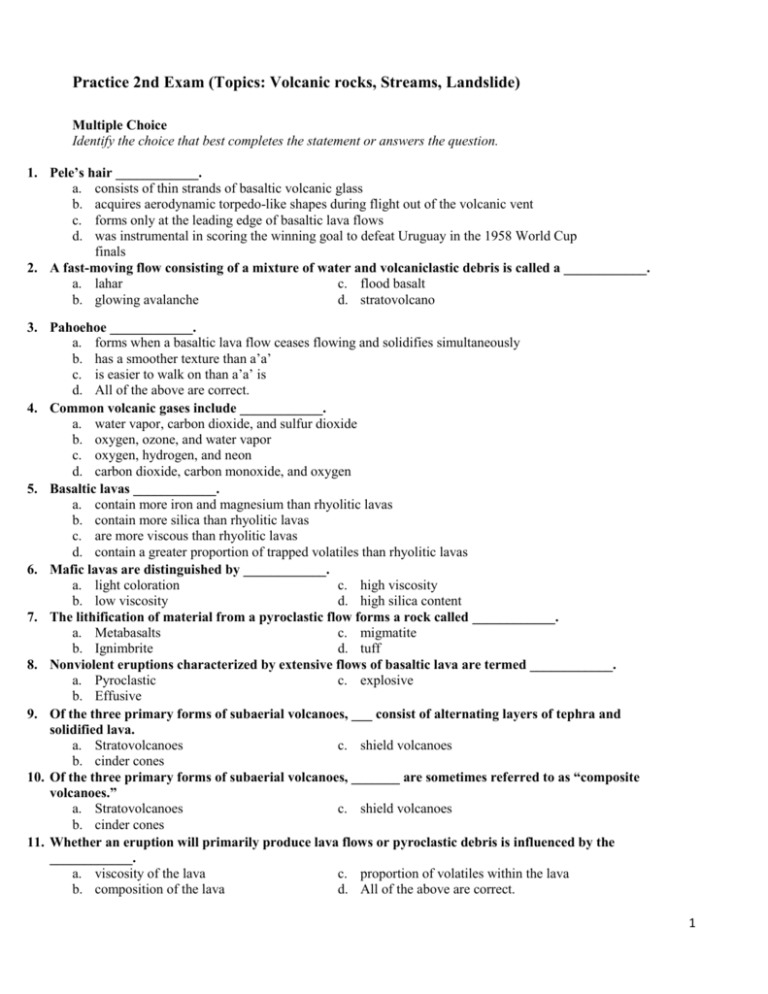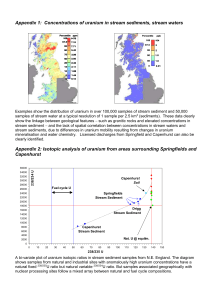2nd_Exam
advertisement

Practice 2nd Exam (Topics: Volcanic rocks, Streams, Landslide) Multiple Choice Identify the choice that best completes the statement or answers the question. 1. Pele’s hair ____________. a. consists of thin strands of basaltic volcanic glass b. acquires aerodynamic torpedo-like shapes during flight out of the volcanic vent c. forms only at the leading edge of basaltic lava flows d. was instrumental in scoring the winning goal to defeat Uruguay in the 1958 World Cup finals 2. A fast-moving flow consisting of a mixture of water and volcaniclastic debris is called a ____________. a. lahar c. flood basalt b. glowing avalanche d. stratovolcano 3. Pahoehoe ____________. a. forms when a basaltic lava flow ceases flowing and solidifies simultaneously b. has a smoother texture than a’a’ c. is easier to walk on than a’a’ is d. All of the above are correct. 4. Common volcanic gases include ____________. a. water vapor, carbon dioxide, and sulfur dioxide b. oxygen, ozone, and water vapor c. oxygen, hydrogen, and neon d. carbon dioxide, carbon monoxide, and oxygen 5. Basaltic lavas ____________. a. contain more iron and magnesium than rhyolitic lavas b. contain more silica than rhyolitic lavas c. are more viscous than rhyolitic lavas d. contain a greater proportion of trapped volatiles than rhyolitic lavas 6. Mafic lavas are distinguished by ____________. a. light coloration c. high viscosity b. low viscosity d. high silica content 7. The lithification of material from a pyroclastic flow forms a rock called ____________. a. Metabasalts c. migmatite b. Ignimbrite d. tuff 8. Nonviolent eruptions characterized by extensive flows of basaltic lava are termed ____________. a. Pyroclastic c. explosive b. Effusive 9. Of the three primary forms of subaerial volcanoes, ___ consist of alternating layers of tephra and solidified lava. a. Stratovolcanoes c. shield volcanoes b. cinder cones 10. Of the three primary forms of subaerial volcanoes, _______ are sometimes referred to as “composite volcanoes.” a. Stratovolcanoes c. shield volcanoes b. cinder cones 11. Whether an eruption will primarily produce lava flows or pyroclastic debris is influenced by the ____________. a. viscosity of the lava c. proportion of volatiles within the lava b. composition of the lava d. All of the above are correct. 1 12. As compared to subaerial basaltic lavas, submarine basaltic lavas differ in that they ____________. a. always produce violent pyroclastic debris flows b. produce large crystals of pyroxene and plagioclase c. form pillow-like mounds because they cannot flow as far from their source d. All of the above are correct. 13. The Columbia River Plateau is an example of a ____________. a. caldera c. flood basalt province b. fissure d. hot spot 14. The Hawaiian island chain is an example of a(n) ____________. a. island volcanic arc c. hot-spot island chain b. continental volcanic arc d. stratovolcanic assembly 15. Which national park has a large volcanic caldera formed by a very large explosive eruption 640,000 years ago? a. Acadia c. Great Smoky Mountains b. Carlsbad Caverns d. Yellowstone 16. Hot-spot volcanoes ____________. a. can arise from the ocean floor b. can arise on continents c. may arise in the interior of lithospheric plates d. All of the above are correct. 17. At continental rifts, vast bodies of basaltic lava flow forth from fissures, forming ____________. a. flood basalts c. ash-fall tuffs b. pyroclastic flows 18. Mt. St. Helens killed a geologist studying the volcano because ____________. a. the geologist disregarded orders to keep a safe distance from the vent b. the eruption produced a greater volume of ash than anyone predicted c. a landslide produced a lateral blast of volcaniclastic debris that no one anticipated d. lahars swept down all sides of the volcano and buried all towns within 100 km 19. The greatest hazard to human life associated with volcanoes is ____________. a. flowing lava c. falling ash b. volcanic gas d. pyroclastic flows 20. What signs do scientists look for when predicting volcanic eruptions? a. changes in earthquake activity c. changes in shape b. increases in gas and steam emission d. All of the above are correct. 21. Which of the following is NOT an effect volcanic eruptions can have on climate? a. They can dim the stars. b. They can lower temperatures for at least a season. c. They can increase the growth rate of tree rings. d. They can cause more radiant sunsets. 22. Different types of mass wasting have different velocities. a. true b. false 23. ____________occur(s) when a semicoherent mass of material moves downslope on a failure surface. a. Avalanches c. Creep b. Slumps d. Solifluction 24. Which type of mass movement includes a large proportion of ash derived from a volcanic eruption? a. Stromboli c. debris flow b. lahar d. Wadi 25. Which of the following types of mass movement is the least coherent internally? a. slump c. rock slide b. creep d. mudflow 2 26. Which of the following types of mass movement is actually a landslide? a. slump c. rock slide b. creep d. mudflow 27. Large ____________ may trigger tsunamis. a. lahars c. avalanches b. submarine mass movements d. rockfalls 28. ____________occur(s) where thawed sediments move downslope over permafrost. a. Avalanches c. Creep b. Slumps d. Solifluction 29. Which of the following types of mass movement takes place most gradually? a. slump c. rock slide b. creep d. mudflow 30. A warming climate at both high elevations and latitudes would increase the area in which solifluction occurs. a. True b. False 31. The principal difference between a lahar and a mudflow is the ____________. a. shape of the path taken by the moving mass b. grain size of the moving mass c. lahar’s abundant water, compared to the dry mudflow d. lahar’s pyroclastic debris content from a volcanic eruption 32. Which of the following types of mass movement is likely to move most rapidly? a. slump c. rock slide b. creep d. Solifluction 33. To the geologist, ____________. a. landslides and mass movements are the same thing b. all mass movements are landslides, but not all landslides are mass movements c. all landslides are mass movements, but not all mass movements are landslides d. mass movements differ from landslides in that a greater mass of material moves during a mass movement than during a landslide 34. You are mapping a new road-cut made through a wide, sloped plain. The road-cut exposes uniformly dipping sedimentary rocks. Which geologic feature listed below would indicate that creep had been occurring in the area before the road-cut was made? a. a layer of rounded clasts in the bedrock b. greater chemical weathering near the top of the newly exposed beds c. a uniform tilting of the sedimentary beds toward the downslope direction of the sloped plain. d. small ravines and ephemeral channels in the plain 35. All regions are susceptible to mass movements. a. true b. False 36. Which of the following increases the risk of mass movement? a. adding a small amount of moisture to dry sediment b. waves breaking on a beach before reaching a vertical sea cliff c. saturating the sediment with water d. reducing the steepness of the slope 37. Fires and deforestation may not lead to slope failure. a. true b. False 38. The immediate cause of mass movement is ____________. a. magnetic attraction c. water content b. gravitational attraction d. frictional resistance 39. Slope stability is determined by which two forces? a. Downslope sliding and resistance c. resistance and gravity b. gravity and friction d. downslope and friction 3 40. Well-rounded sand has a steeper angle of repose than irregularly shaped gravel. a. true b. False 41. Unstable slopes start to move when the ___ force exceeds the ____ force that holds the material in place. a. downslope; gravity c. downslope; frictional resistance b. resistance; downslope d. gravity; resistance 42. Moisture among sediment grains ____________. a. always increases the likelihood of mass wasting b. always decreases the likelihood of mass wasting c. can promote stability if present in small amounts, but promotes mass wasting if sediment is saturated d. can promote stability if the grains are saturated, but the presence of a small amount has little effect on the likelihood of mass wasting 43. The flow of water from a spring on a hillside increases. Why does this make the hillside less stable? a. The increased spring flow will precipitate-out more minerals and make the slope heavier. b. The increased spring flow will cool the hillside and discourage plant growth that normally stabilizes a hillside. c. The increased spring flow will saturate more of the hillside and thereby increase its instability. 44. 45. 46. 47. d. All of the above are correct. Ground shaking can transform wet sediments into liquid-like slurries in a process known as ____________. a. liquefaction c. undercutting b. slumping d. sloping Which type of bedrock provides the greatest risk of landslide? a. granite c. sandstone b. gneiss d. shale ____________ may help stabilize slopes to prevent mass wasting. a. Revegetation c. Preventing undercutting b. Regrading d. All of the above are correct. Highway departments sometimes drill holes into roadside slopes excavated into regolith or weak rock. The holes are drilled to angle slightly upward from the curb, and after drilling is complete a perforated pipe is installed in each hole. How will this help stabilize the roadside slopes? a. Air within the pipes will help dry out the slope. b. Minerals will precipitate into the pipe where water enters it, making the slope stronger. c. Air and bacteria that enter the hillside via the pipe will introduce rooting systems that will stabililize the slope. d. Groundwater will flow into the pipes and drain out, thus decreasing the saturation of the slope. 48. Which of the following factors increase(s) the risk of mass movement? a. Nearby earthquakes c. adding weight to the top of a hill b. excavation into the base of a hill d. All of the above 49. Conditions such as ____________ may exacerbate a developing slump. a. persistent rain c. earthquake aftershocks b. rising floodwaters d. All of the above are correct. 50. In uniform sediments with a relatively constant slope at the surface, a ____________ drainage network is expected. a. dendritic c. rectangular b. radial d. trellis 51. The primary stream fed by tributaries within a drainage basin is termed a ____________. a. lead stream c. taproot stream b. trunk stream d. pirate stream 4 52. In a region with prominent orthogonal sets of joints, a ____________ drainage network is expected. a. dendritic c. rectangular b. radial d. trellis 53. In a region characterized by a parallel series of ridges and valleys, a ____________ drainage network is expected. a. dendritic c. rectangular b. radial d. trellis 54. Ephemeral streams ____________. a. consist of a series of intertwined channels that are overloaded with sediment b. have flowing water either episodically or during a portion of the year c. have a channel that is highly sinuous (curvy) d. divert flow from streams they have intersected through stream erosion. 55. Although the Nile River is longer, the Amazon River has the greatest discharge of any stream on Earth. a. true b. false 56. The deepest part of a mature river channel is where the water usually flows the slowest. a. true b. False 57. As the velocity of flow increases, ____________. a. flow tends to become more turbulent b. the maximum flow velocity increases c. suspended sediment does not get deposited d. All of the above are correct. 58. The discharge of a river traveling through a humid region will typically ____________ downstream; the discharge of a river traveling through an arid region will typically ____________ downstream. a. increase; increase c. increase; decrease b. decrease; decrease d. decrease; increase 59. Which sediment load carries electrically charged ions? a. bed load c. suspended load b. dissolved load d. bank load 60. Which sediment load is likely to move the least, in between periods of flood? a. bed load c. suspended load b. dissolved load d. bank load 61. Which has greater competence? a. a small, steep mountain stream b. a broad, slow-flowing river 62. Which has greater capacity? a. a small, steep mountain stream b. a broad, slow-flowing river 63. All else being equal, water will flow faster in a stream with ____________. a. well-developed meanders b. a straight channel 64. The slope of a stream surface measured between two points along its course is the ____________. a. base level c. gradient b. floodplain d. thalweg 65. The stream gradient of most rivers ____________. a. is greater near the source than near the mouth b. is greater near the mouth than near the source c. does not change significantly as the river flows downstream d. is greater for a meandering stream than for any other type 66. All else being equal, water will flow slower in a stream that has a ____________. a. steep stream gradient b. gentle stream gradient 67. Ultimately, the base level of a stream valley can be no lower than ____________. a. the average elevation of the continent on which it is found b. the level of water in the world’s oceans c. the average depths of the world’s ocean basins 5 68. Moving downstream, the flow of a stream or river usually becomes less ____________. a. turbulent c. meandering b. saline d. Laminar 69. Within a meander, where is sediment most likely to be deposited? a. on the outer bank (cut bank) of the meander b. on the inner bank (point bar) of the meander c. uniformly to either side of the meander 70. The flat-lying area surrounding a river channel is termed the ____________. a. base level c. stream gradient b. floodplain d. thalweg 71. The shape of a delta is primarily determined by ____________. a. the shape of the river channel near the mouth b. the average grain size of the suspended and bed loads c. whether river currents, wave-driven currents, or tidal currents are locally predominant d. the type of rock that is weathering at outcrop near the headwaters of the river 72. A meander that is cut off to become completely isolated from the main channel, but that retains water, is a(n) _______. a. meander neck c. oxbow lake b. cut bank d. abandoned meander 73. The deltas of all major rivers consist of multiple radiating lobes of sediment in a “bird’s foot” configuration, similar to the Mississippi River Delta. a. true b. false 74. At a delta, ____________. a. stream gradient decreases b. a single channel breaks into multiple, radiating distributary channels c. a and b are both correct. d. None of the above is correct. 75. Pirate streams ____________. a. consist of a series of intertwined channels that are overloaded with sediment b. have flowing water either episodically or during a portion of the year c. have a channel that is highly sinuous (curvy) d. have increased their drainage areas 76. If a stream cuts through flat-lying sediments to reach an anticline produced in an ancient orogenic event, the course of the stream will likely be affected. a. true b. false 77. All flooding events occur so rapidly that there is no time to alert people in harm’s way. a. true b. false 78. A 100-year flood is less catastrophic than a 50-year flood. a. true b. false 79. If a 50-year flood occurs on the Mississippi River in 2005, what is the probability that a flood of the same magnitude will occur in 2006? a. Zero c. 2% b. 1% d. 50% 80. In areas that have become urbanized, the percolation of rainwaters tends to decrease and the speed at which rainwaters flow into streams and rivers tends to increase. Which of the following would be good ways to counteract this effect? a. Dig drainage ditches to the streams and rivers, for rainwaters to flow through quickly. b. Dig out shallow areas for rainwater runoff to collect into, to allow slow percolation into soils. c. Increase the carrying capacity of storm water sewer systems. d. Both A and C 6 81. Volcanic bombs _____. A. B. C. D. are pyroclastic blocks that acquire aerodynamic shapes during flight out of the volcanic vent are explosive bodies of lava with high volatile content are cinders that explode upon impact with the ground are used by geologists to set off small eruptions in volcanoes that are deemed potentially dangerous. 82. If a 10-year flood occurs on the Mississippi River in 2003, what is the probability that a flood of at the same magnitude will occur in 2004? A. zero B. 1% C. 10% D. 50% 83. The water table typically lies above the bottom of a stream in a _____ climate. A. hot B. cold C. moist D. dry 84. Which has greater capacity, a small mountain stream, or the Mississippi River? A. the mountain stream B. the Mississippi 85. A stream begins at an elevation of 200 meters and flows a distance of 400 kilometers to the ocean? What is the average gradient? a. 2m/km b. 2km/m c. 0.5m/km d. 0.5km/in 86. The product of the average flow velocity and the area (width x depth) of the channel cross section. a. Runoff gradient b. Stream discharge c. Hydrocapacity d. Stream load factor 7







